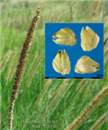Scientific name(s)
Setaria incrassata
Strengths
- Large seed.
- Easy to harvest, handle and sow.
- Can be drilled into moist soil.
- Good emergence from depth, to 50mm.
- Relatively easy to establish on heavy, black cracking-clay soils.
- Vigorous seedlings.
- High growth rate.
- Tolerant of temporary waterlogging.
- Drought tolerant.
Limitations
- Freshly harvested seed is dormant for 7-18 months.
- Less palatable than some other improved grasses, such as green panic and Bambatsi.
- Needs moderate to high fertility soil.
- Intolerant of continuous heavy grazing.
- Contains relatively high concentration of oxalate, therefore not suited to horses continuously grazing pure stands.
Plant description
Plant: A tufted perennial grass.
Stems: Stems are 30-200 cm high with hairy nodes.
Leaves: Leaves are flat or rolled, 10-60 cm long, 3-15 mm wide, tapering to a long fine point. Ligule is a fringe of hairs.
Seedhead: Seedhead is a dense, continuous false spike, 3-30 cm long, 8 mm wide (excluding the bristles).
Seeds: 560,000-960,000 seeds/kg.
Pasture type and use
A medium-term pasture and long-term if sufficient nitrogen fertiliser is applied. It is suitable for short-term pastures.
Where it grows
Rainfall
It is grown in areas with 500 -1200 mm/yr.
Soils
It is adapted to heavy clays to fertile loams.
Temperature
It grows during the warm season and tops are killed by heavy frost.
Establishment
Companion species
Grasses: rhodes grass, Bambatsi.Legumes: lucerne, annual medics, butterfly pea, desmanthus, burgundy bean (all with low grass sowing rate).
Sowing/planting rates as single species
3-5 kg/ha.
Sowing/planting rates in mixtures
1-3 kg/ha.
Sowing time
It is sown from spring to late summer.
Inoculation
Not applicable
Fertiliser
Fertiliser is not required for establishment on fallowed fertile soil.
Management
Maintenance fertliser
A minimum of 50 kg N/ha/yr is needed to maintain stands.
Grazing/cutting
Periodic summer resting will help prolong life of stand. Pasture production in the first two years is superior to that of most other suitable grasses. Palatable hay can be produced.
Seed production
300 kg/ha from each of two harvests per year may be produced from well fertilised stands with good soil moisture. Good seed production after the first year is dependent on applying a minimum of 100 kg N/ha.
Ability to spread
It only spreads by seed in fertile bare soils.
Weed potential
It exhibits minimal weed potential.
Major pests
There are no known major pests.
Major diseases
There are no known major diseases.
Herbicide susceptibility
It is killed by glyphosate and atrazine.
Animal production
Feeding value
The growth of cattle grazing tropical pasture grasses, including purple pigeon grass, is limited by low dry matter digestibility, especially in winter. Supplementary nitrogen will increase feed intake in deficient situations.
Palatability
It is not as palatable as some suitable companion grasses.
Production potential
Live weight gain in pure stands is equal to or better than from other improved grasses.
Livestock disorders/toxicity
It can cause bighead in horses continuously grazing pure stands due to high oxalate concentration.
Cultivars
| Cultivar | Seed source/Information |
| Inverell | Australian Herbage Plant Cultivars |
 Denotes that this variety is protected by Plant Breeder's Rights Australia
Denotes that this variety is protected by Plant Breeder's Rights Australia
Further information
Web links:Tropical Forages database (SoFT) - Purple pigeon grassGrassBaseTropical Grasslands SocietyPurple pigeon grass (QDPI&F)Purple pigeon grass - Agnote DPI-292 (NSWDPI)Purple pigeon grass - Agfact P2.5.21 (NSWDPI)
Acknowledgements
-
Author and date
Dr. Walter Scattini
December 2008





